-

新人教版高中英语选修2Unit 3 Reading for writing教学设计
The theme of this part is to write an article about healthy diet. Through reading and writing activities, students can accumulate knowledge about healthy diet, deepen their understanding of the theme of healthy diet, and reflect on their own eating habits. This text describes the basic principles of healthy diet. The author uses data analysis, definition, comparison, examples and other methods. It also provides a demonstration of the use of conjunctions, which provides important information reference for students to complete the next collaborative task, writing skills, vivid language materials and expressions.1. Teach Ss to learn and skillfully use the new words learned from the text.2. Develop students’ ability to understand, extract and summarize information.3. Guide students to understand the theme of healthy diet and reflect on their own eating habits.4. To guide students to analyze and understand the reading discourse from the aspects of theme content, writing structure, language expression, etc., 5. Enable Ss to write in combination with relevant topics and opinions, and to talk about their eating habits.1. Guide students to analyze and understand the reading discourse from the aspects of theme content, writing structure, language expression, etc.2. Enable them to write in combination with relevant topics and opinions, and to talk about their eating habits.3. Guide the students to use the cohesive words correctly, strengthen the textual cohesion, and make the expression fluent and the thinking clear.Step1: Warming upbrainstorm some healthy eating habits.1.Eat slowly.2.Don’t eat too much fat or sugar.3.Eat healthy food.4.Have a balanced diet.Step2: Read the passage and then sum up the main idea of each paragraph.

新人教版高中英语选修2Unit 2 Reading for writing教学设计
The theme of this section is to express people's views on studying abroad. With the continuous development of Chinese economic construction, especially the general improvement of people's living standards, the number of Chinese students studying abroad at their own expense is on the rise. Many students and parents turn their attention to the world and regard studying abroad as an effective way to improve their quality, broaden their horizons and master the world's advanced scientific knowledge, which is very important for the fever of going abroad. Studying abroad is also an important decision made by a family for their children. Therefore, it is of great social significance to discuss this issue. The theme of this section is the column discussion in the newspaper: the advantages and disadvantages of studying abroad. The discourse is about two parents' contribution letters on this issue. They respectively express their own positions. One thinks that the disadvantages outweigh the advantages, and the other thinks that the advantages outweigh the disadvantages. The two parents' arguments are well founded and logical. It is worth noting that the two authors do not express their views on studying abroad from an individual point of view, but from a national or even global point of view. These two articles have the characteristics of both letters and argumentative essays1.Guide the students to read these two articles, and understand the author's point of view and argument ideas2.Help the students to summarize the structure and writing methods of argumentative writing, and guides students to correctly understand the advantages and disadvantages of studying abroad3.Cultivate students' ability to analyze problems objectively, comprehensively and deeply

新人教版高中英语选修2Unit 2 Using langauge-Listening教学设计
? B: Absolutely! Getting involved with Chinese cultural activities there definitely helped a lot. I got to practice my Chinese on a daily basis, and I could learn how native Chinese speakers spoke.? A: What do you feel is your biggest achievement?? B: Learning Chinese characters! I have learnt about 1,500 so far. When I first started, I didn't think it was even going to be possible to learn so many, but now I find that I can read signs, menus, and even some easy newspaper articles.? A: What are you most keen on?? B: I've really become keen on learning more about the Chinese culture, in particular Chinese calligraphy. As I have learnt Chinese characters, I have developed a great appreciation for their meaning. I want to explore Chinese characters by learning how to write them in a more beautiful way. ? A: Finally, what do you want to say to anyone interested in learning Chinese?? I have really become keen on learning more about the Chinese culture, in particular Chinese Calligraphy. As I have learnt Chinese character, I have developed a great appreciation for their meaning. I want to explore Chinese characters by learning how to write them in a more beautiful way.? A: Finally, what do you want to say to anyone interested in learning Chinese?? B: I'd say, give it a shot! While some aspects may be difficult, it is quite rewarding and you will be happy that you tried.? A: Thanks for your time. ? B:You're welcome.

新人教版高中英语选修2Unit 3 Using langauge-Listening教学设计
1. How is Hunan cuisine somewhat different from Sichuan cuisine?The heat in Sichuan cuisine comes from chilies and Sichuan peppercorns. Human cuisine is often hotter and the heat comes from just chilies.2.What are the reasons why Hunan people like spicy food?Because they are a bold people. But many Chinese people think that hot food helps them overcome the effects of rainy or wet weather.3.Why do so many people love steamed fish head covered with chilies?People love it because the meat is quite tender and there are very few small bones.4.Why does Tingting recommend bridge tofu instead of dry pot duck with golden buns?Because bridge tofu has a lighter taste.5 .Why is red braised pork the most famous dish?Because Chairman Mao was from Hunan, and this was his favorite food.Step 5: Instruct students to make a short presentation to the class about your choice. Use the example and useful phrases below to help them.? In groups of three, discuss what types of restaurant you would like to take a foreign visitor to, and why. Then take turns role-playing taking your foreign guest to the restaurant you have chosen. One of you should act as the foreign guest, one as the Chinese host, and one as the waiter or waitress. You may start like this:? EXAMPLE? A: I really love spicy food, so what dish would you recommend?? B: I suggest Mapo tofu.? A: Really ? what's that?

新人教版高中英语选修2Unit 4 Learning about Language教学设计
This section guides students to pay attention to the typical context of vocabulary use, helps students accumulate vocabulary around the key vocabulary of this unit, and uses the learned words and word chunks in different contexts to deeply understand their meaning and usage, so as to achieve the purpose of review and consolidation.The teaching design activities aim to guide students to pay attention to the typical context in which the target vocabulary is used, as well as the common vocabulary used in collocation, so that students can complete the sentence with correct words. In terms of vocabulary learning strategies, this unit focuses on cultivating students' ability to pay attention to collocation of words and to use word blocks to express meaning.For vocabulary learning, it is not enough just to know the meaning of a single word, but the most important thing is to master the common collocations of words, namely word blocks.Teachers should timely guide students to summarize common vocabulary collocation, such as verb and noun collocation, verb and preposition collocation, preposition and noun collocation, and so on.1. Guide students to understand and consolidate the meaning and usage of the vocabulary in the context, 2. Guide the students to use the unit topic vocabulary in a richer context3. Let the students sort out and accumulate the accumulated vocabulary, establishes the semantic connection between the vocabulary,4. Enable students to understand and master the vocabulary more effectivelyGuiding the Ss to use unit topic words and the sentence patterns in a richer context.

新人教版高中英语选修2Unit 4 Using langauge-Listening教学设计
The theme of the listening section is " talking about scenery and culture along a journey."The part is designed to further lead the students to understand Canadian natural geography and social environment, and integrated into the cultural contrast by mentioning the long train journey from Beijing to Moscow routes. On this basis, the part activates students related travel experience, lets the student serial dialogue, guides the student to explore further the pleasure and meaning of the long journey, and Chinese and foreign cultural comparison.The part also provides a framework for the continuation of the dialogue, which is designed to provide a framework for students to successfully complete their oral expressions, and to incorporate an important trading strategy to end the dialogue naturally.1. Help students to understand and master some common English idioms in the context, and experience the expression effect of English idioms.2. Guide the students to understand the identity of different people in the listening context, and finish the dialogue according to their own experience.3. Instruct the students to use appropriate language to express surprise and curiosity about space and place in the dialogue, and master the oral strategy of ending the dialogue naturally.1. Instruct students to grasp the key information and important details of the dialogue.2. Instruct students to conduct a similar talk on the relevant topic.

新人教版高中英语选修2Unit 5 Learning about Language教学设计
The purpose of this section of vocabulary exercises is to consolidate the key words in the first part of the reading text, let the students write the words according to the English definition, and focus on the detection of the meaning and spelling of the new words. The teaching design includes use English definition to explain words, which is conducive to improving students' interest in vocabulary learning, cultivating their sense of English language and thinking in English, and making students willing to use this method to better grasp the meaning of words, expand their vocabulary, and improve their ability of vocabulary application. Besides, the design offers more context including sentences and short passage for students to practice words flexibly.1. Guide students to understand and consolidate the meaning and usage of the vocabulary in the context, 2. Guide the students to use the unit topic vocabulary in a richer context3. Let the students sort out and accumulate the accumulated vocabulary, establishes the semantic connection between the vocabulary,4. Enable students to understand and master the vocabulary more effectivelyGuiding the Ss to use unit topic words and the sentence patterns in a richer context.Step1: Read the passage about chemical burns and fill in the blanks with the correct forms of the words in the box.

新人教版高中英语选修2Unit 5 Using langauge-Listening教学设计
The theme of this section is to learn how to make emergency calls. Students should learn how to make emergency calls not only in China, but also in foreign countries in English, so that they can be prepared for future situations outside the home.The emergency telephone number is a vital hotline, which should be the most clear, rapid and effective communication with the acute operator.This section helps students to understand the emergency calls in some countries and the precautions for making emergency calls. Through the study of this section, students can accumulate common expressions and sentence patterns in this context. 1.Help students accumulate emergency telephone numbers in different countries and learn more about first aid2.Guide the students to understand the contents and instructions of the telephone, grasp the characteristics of the emergency telephone and the requirements of the emergency telephone.3.Guide students to understand the first aid instructions of the operators.4.Enable Ss to make simulated emergency calls with their partners in the language they have learned1. Instruct students to grasp the key information and important details of the dialogue.2. Instruct students to conduct a similar talk on the relevant topic.Step1:Look and discuss:Match the pictures below to the medical emergencies, and then discuss the questions in groups.
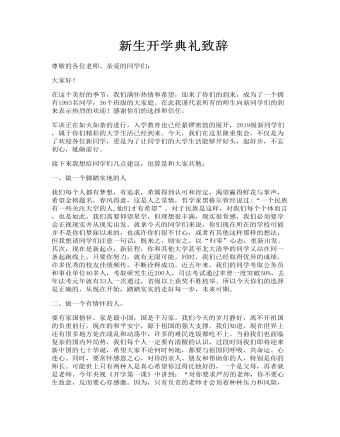
新生开学典礼致辞发言讲话
一、做一个脚踏实地的人我们每个人都有梦想,有追求,希冀得到认可和肯定,渴望赢得鲜花与掌声,希望金榜题名,春风得意,这是人之常情,哲学家黑格尔曾经说过:“一个民族有一些关注天空的人,他们才有希望”。对于民族是这样,对我们每个个体而言,也是如此,我们需要仰望星空,但理想很丰满,现实很骨感,我们必须要学会正视现实并从现实出发。就拿今天的同学们来说,你们现在所在的学校可能并不是你们梦寐以求的,也或许你们很不甘心,或者有其他这样那样的想法,但我想请同学们注意一句话:既来之,则安之。以“归零”心态,重新出发。其次,现在是新起点,新征程,你和其他大学甚至北大清华的同学又站在同一条起跑线上,只要你努力,就有无限可能。同时,我们已经取得优异的成绩,许多优秀的校友佳绩频传,不断诠释成功。近五年来,我们的同学考取公务员和事业单位40多人,考取研究生近200人,司法考试通过率曾一度突破50%,去年法考元年就有33人一次通过,省级以上获奖不胜枚举。所以今天你们的选择是正确的,从现在开始,踏踏实实的走好每一步,未来可期。
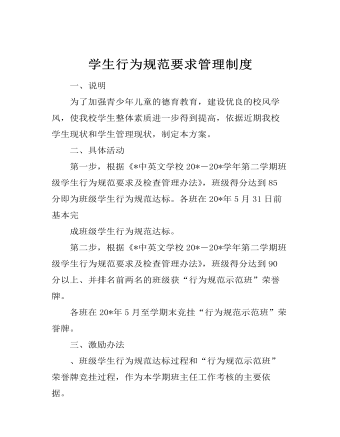
学生行为规范要求管理制度
二、具体活动 第一步,根据《*中英文学校20*-20*学年第二学期班级学生行为规范要求及检查管理办法》,班级得分达到85分即为班级学生行为规范达标。各班在20*年5月31日前基本完 成班级学生行为规范达标。 第二步,根据《*中英文学校20*-20*学年第二学期班级学生行为规范要求及检查管理办法》,班级得分达到90分以上、并排名前两名的班级获“行为规范示范班”荣誉牌。 各班在20*年5月至学期末竞挂“行为规范示范班”荣誉牌。 三、激励办法 、班级学生行为规范达标过程和“行为规范示范班”荣誉牌竞挂过程,作为本学期班主任工作考核的主要依据。 2、本学期在竞挂“行为规范示范班”荣誉牌活动中,中小学各选出两个班级,在下学期开学典礼上给予奖励。
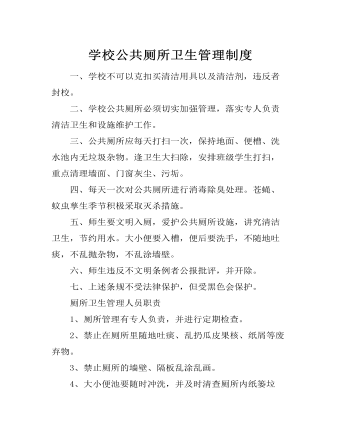
学校公共厕所卫生管理制度
三、公共厕所应每天打扫一次,保持地面、便槽、洗水池内无垃圾杂物。逢卫生大扫除,安排班级学生打扫,重点清理墙面、门窗灰尘、污垢。 四、每天一次对公共厕所进行消毒除臭处理。苍蝇、蚊虫孳生季节积极采取灭杀措施。 五、师生要文明入厕,爱护公共厕所设施,讲究清洁卫生,节约用水。大小便要入槽,便后要洗手,不随地吐痰,不乱抛杂物,不乱涂墙壁。
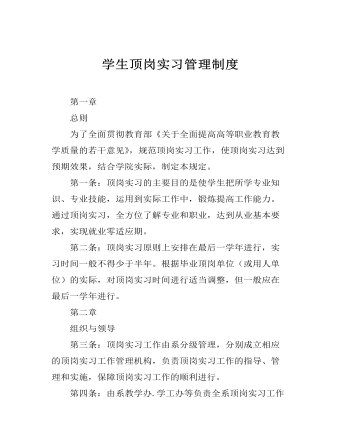
学生顶岗实习管理制度通用
第一条:顶岗实习的主要目的是使学生把所学专业知识、专业技能,运用到实际工作中,锻炼提高工作能力。通过顶岗实习,全方位了解专业和职业,达到从业基本要求,实现就业零适应期。 第二条:顶岗实习原则上安排在最后一学年进行,实习时间一般不得少于半年。根据毕业顶岗单位(或用人单位)的实际,对顶岗实习时间进行适当调整,但一般应在最后一学年进行。 第二章 组织与领导 第三条:顶岗实习工作由系分级管理,分别成立相应的顶岗实习工作管理机构,负责顶岗实习工作的指导、管理和实施,保障顶岗实习工作的顺利进行。 第四条:由系教学办.学工办等负责全系顶岗实习工作的管理。主要职责是审核各班的顶岗实习工作计划;检查考核各班顶岗实习计划的落实情况、管理质量并提出整改意见和建议;组织全系顶岗实习工作经验交流;保证实习经费;研究解决顶岗实习管理中的问题;积极推动校企合作,协助我系联系和落实顶岗实习单位;督促、协助统一办理顶岗实习期间的学生安全保险;研究解决我系校外实习基地管理机构人员和聘请的实习单位技术骨干、能工巧匠等兼职指导教师的管理和报酬问题;着力推进以就业为目标的顶岗实习工作。
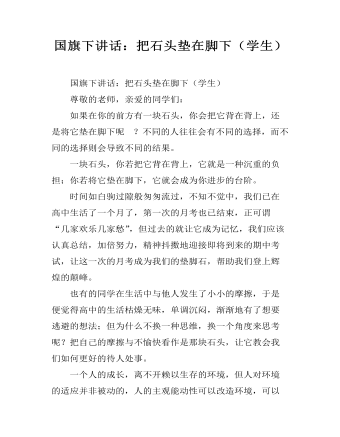
国旗下讲话:把石头垫在脚下(学生)
尊敬的老师,亲爱的同学们:如果在你的前方有一块石头,你会把它背在背上,还是将它垫在脚下呢 ?不同的人往往会有不同的选择,而不同的选择则会导致不同的结果。一块石头,你若把它背在背上,它就是一种沉重的负担;你若将它垫在脚下,它就会成为你进步的台阶。时间如白驹过隙般匆匆流过,不知不觉中,我们已在高中生活了一个月了,第一次的月考也已结束,正可谓“几家欢乐几家愁”,但过去的就让它成为记忆,我们应该认真总结,加倍努力,精神抖擞地迎接即将到来的期中考试,让这一次的月考成为我们的垫脚石,帮助我们登上辉煌的颠峰。也有的同学在生活中与他人发生了小小的摩擦,于是便觉得高中的生活枯燥无味,单调沉闷,渐渐地有了想要逃避的想法;但为什么不换一种思维,换一个角度来思考呢?
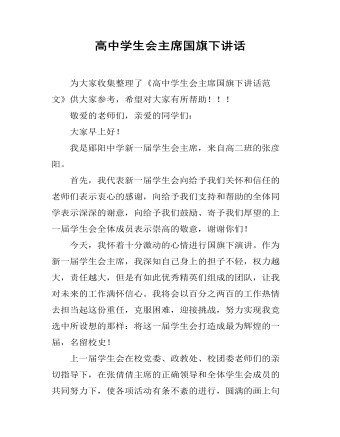
高中学生会主席国旗下讲话
为大家收集整理了《高中学生会主席国旗下讲话范文》供大家参考,希望对大家有所帮助!!!敬爱的老师们,亲爱的同学们:大家早上好!我是郧阳中学新一届学生会主席,来自高二班的张彦阳。首先,我代表新一届学生会向给予我们关怀和信任的老师们表示衷心的感谢,向给予我们支持和帮助的全体同学表示深深的谢意,向给予我们鼓励、寄予我们厚望的上一届学生会全体成员表示崇高的敬意,谢谢你们!今天,我怀着十分激动的心情进行国旗下演讲。作为新一届学生会主席,我深知自己身上的担子不轻,权力越大,责任越大,但是有如此优秀精英们组成的团队,让我对未来的工作满怀信心。我将会以百分之两百的工作热情去担当起这份重任,克服困难,迎接挑战,努力实现我竞选中所设想的那样:将这一届学生会打造成最为辉煌的一届,名留校史!
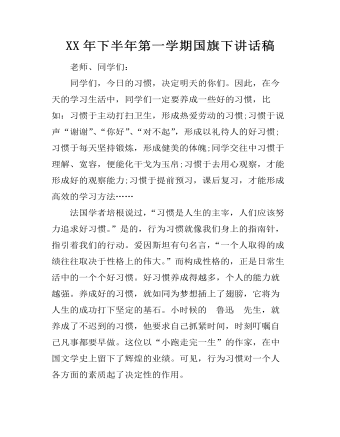
XX年下半年第一学期国旗下讲话稿
老师、同学们:同学们,今日的习惯,决定明天的你们。因此,在今天的学习生活中,同学们一定要养成一些好的习惯,比如:习惯于主动打扫卫生,形成热爱劳动的习惯;习惯于说声“谢谢”、“你好”、“对不起”,形成以礼待人的好习惯;习惯于每天坚持锻炼,形成健美的体魄;同学交往中习惯于理解、宽容,便能化干戈为玉帛;习惯于去用心观察,才能形成好的观察能力;习惯于提前预习,课后复习,才能形成高效的学习方法……法国学者培根说过,“习惯是人生的主宰,人们应该努力追求好习惯。”是的,行为习惯就像我们身上的指南针,指引着我们的行动。爱因斯坦有句名言,“一个人取得的成绩往往取决于性格上的伟大。”而构成性格的,正是日常生活中的一个个好习惯。好习惯养成得越多,个人的能力就越强。养成好的习惯,就如同为梦想插上了翅膀,它将为人生的成功打下坚定的基石。小时候的 鲁迅 先生,就养成了不迟到的习惯,他要求自己抓紧时间,时刻叮嘱自己凡事都要早做。这位以“小跑走完一生”的作家,在中国文学史上留下了辉煌的业绩。可见,行为习惯对一个人各方面的素质起了决定性的作用。
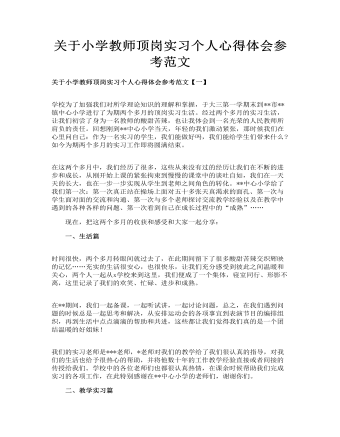
关于小学教师顶岗实习个人心得体会参考范文
在实习的日子里,我们主要负责二年级、五年级和六年级的体育课教学。在实习最开始的时候我们看指导老师上课,以一个“老师”的身份看他是如何上课的,学习他如何传授知识、驾驭课堂,如何控制授课时间等等。通过听课我发现教师不仅对知识和技能的把握很重要,对学生的课堂纪律、积极性的调动都很重要。只有把握好课堂纪律、学生学习的积极性,才能让我们的学生在上课的时候真正的学到运动技能,并真正达到锻炼身体的目的。
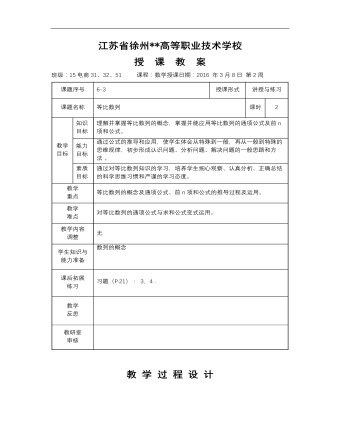
高教版中职数学基础模块下册:6.3《等比数列》教学设计
课题序号6-3授课形式讲授与练习课题名称等比数列课时2教学 目标知识 目标理解并掌握等比数列的概念,掌握并能应用等比数列的通项公式及前n项和公式。能力 目标通过公式的推导和应用,使学生体会从特殊到一般,再从一般到特殊的思维规律,初步形成认识问题、分析问题、解决问题的一般思路和方法 。素质 目标通过对等比数列知识的学习,培养学生细心观察、认真分析、正确总结的科学思维习惯和严谨的学习态度。教学 重点等比数列的概念及通项公式、前n项和公式的推导过程及运用。教学 难点对等比数列的通项公式与求和公式变式运用。教学内容 调整无学生知识与 能力准备数列的概念课后拓展 练习 习题(P.21): 3,4.教学 反思 教研室 审核
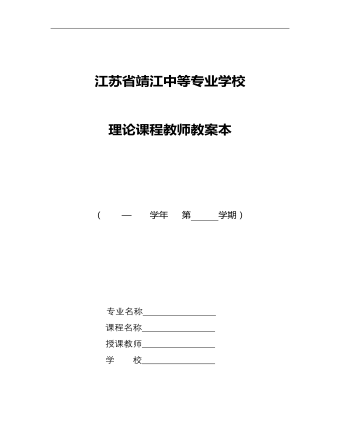
高教版中职数学基础模块下册:9.5《柱、锥、球及其简单组合体》教学设计
课题序号 授课班级 授课课时2授课形式 教学方法 授课章节 名称9.5柱、锥、球及其组合体使用教具 教学目的1、使学生认识柱、锥、球及其组合体的结构特征,并能运用这些特征描述生活中简单物体的结构。 2、让学生了解柱、锥、球的侧面积和体积的计算公式。 3、培养学生观察能力、计算能力。
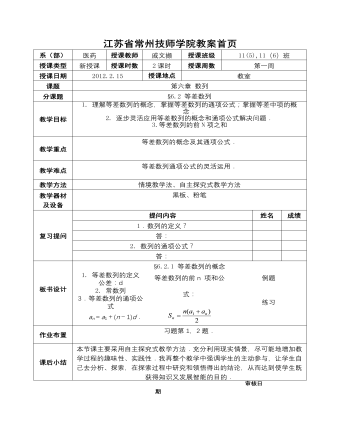
高教版中职数学基础模块下册:6.2《等差数列》教学设计
系(部)医药授课教师戚文撷授课班级11(5),11(6)班授课类型新授课授课时数2课时授课周数第一周授课日期2012.2.15授课地点 教室课题第六章数列分课题§6.2 等差数列教学目标1. 理解等差数列的概念,掌握等差数列的通项公式;掌握等差中项的概念. 2. 逐步灵活应用等差数列的概念和通项公式解决问题. 3.等差数列的前N项之和 . 4.培养学生分析、比较、归纳的逻辑思维能力. . 2. 3.教学重点等差数列的概念及其通项公式. 教学难点等差数列通项公式的灵活运用. 教学方法情境教学法、自主探究式教学方法教学器材及设备黑板、粉笔复习提问提问内容姓名成绩1.数列的定义? 答: 2. 数列的通项公式? 答: 板书设计 §6.2.1等差数列的概念 1. 1.等差数列的定义 公差:d 2.常数列 3.等差数列的通项公式 an=a1+(n-1)d. 等差数列的前n 项和公式: 例题 练习作业布置习题第1,2题.课后小结本节课主要采用自主探究式教学方法.充分利用现实情景,尽可能地增加教学过程的趣味性、实践性.我再整个教学中强调学生的主动参与,让学生自己去分析、探索,在探索过程中研究和领悟得出的结论,从而达到使学生既获得知识又发展智能的目的.
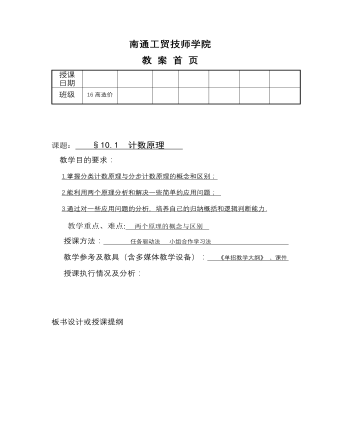
高教版中职数学基础模块下册:10.1《计数原理》教学设计
授课 日期 班级16高造价 课题: §10.1 计数原理 教学目的要求: 1.掌握分类计数原理与分步计数原理的概念和区别; 2.能利用两个原理分析和解决一些简单的应用问题; 3.通过对一些应用问题的分析,培养自己的归纳概括和逻辑判断能力. 教学重点、难点: 两个原理的概念与区别 授课方法: 任务驱动法 小组合作学习法 教学参考及教具(含多媒体教学设备): 《单招教学大纲》、课件 授课执行情况及分析: 板书设计或授课提纲 §10.1 计数原理 1、加法原理 2、乘法原理 3、两个原理的区别

